
94% of researchers rate our articles as excellent or good
Learn more about the work of our research integrity team to safeguard the quality of each article we publish.
Find out more
ORIGINAL RESEARCH article
Front. Phys., 23 July 2024
Sec. Social Physics
Volume 12 - 2024 | https://doi.org/10.3389/fphy.2024.1327161
This article is part of the Research TopicCompartmental Models for Social InteractionsView all 6 articles
Introduction: Studying the main factors and related paths of rumor propagation contributes to the precise governance of rumor information in social networks. Most existing network representation learning methods do not fit with real-world information propagation networks well, and the network cannot effectively model the temporal characteristics and dynamic evolution features of rumor information propagation.
Methods: Our study proposes a new dynamic network representation model for information propagation. Additionally, the study introduces a feedback mechanism where the latest node representations are fed back to neighboring nodes.
Results: The method solves the problem of delayed network representation and improves network representation performance.
Discussion: We conducted experimental simulations, and the results indicate that a higher level of trust contributes to stable group relationships and converging opinions, reducing the likelihood of opinion dispersion. Furthermore, novelty of topics, and interactivity between users, and opinion leaders exhibit distinct characteristics in guiding public opinion. The viewpoint evolution of the newly constructed dynamic network representation model aligns more closely with viewpoint evolution in real-world social networks.
The academic community generally defines rumors as unconfirmed and unfounded viewpoints that are often misleading and provocative, and typically align with the characteristics of the era, making them easily believed by the public. The high-speed diffusion of information available in modern data networks and the technological advances have led to some significant industrial and social advance, and have also generated an environment conducive for disinformation [1]. The general public can use online platforms to express their personal opinions and opinions on different events, interact with other individuals [2], and form social group perspectives. Different viewpoints interact with each other to form public opinion, which is also known as public opinion dynamics. The spread of disinformation has brought numerous adverse consequences [3]. Such as false information disturbing the Nigerian elections, COVID-19 vaccine hesitancy. The misinformation spread not only increases the difficulty of handling sudden public events but also hurts social harmony and stability. In severe cases, it can even pose a threat to social harmony, security, and stability. Therefore, having a scientific understanding and accurate grasp of the inherent laws of the spread and dissemination of online rumors, and timely and scientifically guiding and controlling online public opinion, is of great theoretical and practical significance for maintaining social harmony and stability.
The study of the dissemination and evolution of viewpoints can empower individuals to have a deeper understanding of the inherent mechanisms of viewpoint evolution, design scientific decision-making processes, and guide positive social public opinion. Therefore, it has significant theoretical and practical significance. From a theoretical perspective, research on the dissemination and evolution of viewpoints can deepen people’s understanding and comprehension of the inherent mechanisms of viewpoint evolution, explaining complex public opinion phenomena such as group decision-making, viewpoint differentiation, consensus building, rumor dissemination, and the spread of extreme viewpoints. From an applied perspective, establishing models of opinion dissemination and evolution, it is possible to better predict and control social behavior and public opinion. The monitoring of public opinion, can more effectively guide the dissemination of mainstream perspectives, combat and eliminate the spread of rumors and extremist perspectives, and make the mainstream viewpoints of the group more in line with the values of the nation and society.
In real life, the information network is often dynamic rather than static. Social networks are constantly gaining new users or losing existing ones, and the evolution of perspectives is also shaped by the ever-changing social dynamics. The representation learning of dynamic information networks has attracted widespread attention. With the development of network representation learning, many new representation learning models have been proposed. Perozzi [4] and others describe the network embedding problem as a problem based on DeepWalk sequence modeling, generating node sequences through random strolls, and using Skip-Gram to learn node representations. The purpose of Skip-Gram is to predict the corresponding upper and lower nodes based on the current node center word. The DeepWalk algorithm is based on random walks and cannot capture the global structural information of nodes. In order to improve DeepWalk, GROVER, and others, based on the DeepWalk model, use the Node2vec [5] algorithm to integrate depth-first search and breadth-first search strategies, which can more flexibly explore network structural information. However, The above methods can only be utilized for static network representation.
The interactive systems of the real world are dynamic, with their edges and nodes constantly changing over time. The temporal characteristics are an crucial manifestation of dynamic networks and reflect the mechanisms of network evolution. Therefore, static network representation learning is not applicable in the field of information dissemination research. However, there is currently relatively little research on dynamic networks, and most studies are limited to discrete-time dynamic graphs represented as sequences of graph snapshots [6,10]. Liu et al [7] proposed a real-time distributed graph partitioning and embedding algorithm, which is a dynamic graph embedding method capable of handling real-time data input challenges and addressing the limitation of static network representation1. Additionally, Chanathip et al [8] introduced a new graph embedding algorithm that incorporates auxiliary relationship vectors and modifies the deep learning structure to capture user reference relationships, improving the accuracy of graph embedding2. However, these methods apply static network deep learning models to dynamic networks by ignoring temporal evolution characteristics, which is not the optimal solution. Furthermore, they require retraining for each time slice, resulting in significant time costs. Moreover, while these methods can demonstrate the changing characteristics of networks at different time points, they lack the exploration of the essential attributes of network dynamic changes and do not sufficiently model the highly dynamic nature of real networks [9].
In recent years, deep learning technology has demonstrated excellent performance in various tasks across many fields. In the field of information propagation, there is a relatively universal process for utilizing deep learning technology to handle dynamic information propagation tasks. Chen et al [10, 11] focus on the dynamic changes in network structure, Gao et al [12] propose that the network topology of the response network appears as a position-driven network topology, which is not independent but needs to be presented in a specific form and is related to the topology of the driving network. Clauio et al [13] proposed a classification method based on algorithmic dynamic graph embedding technology that not only addresses the representation of network dynamics but also captures temporal behavior within the network. Xing et al [14] introduced a new DynHEN model, multiple non-linear layers are employed to learn structural patterns within each network layer. Additionally, recursive layers are utilized to learn temporal transformations within the network. This model learns node representations at each time step while capturing dynamics. Tian et al [15] proposed the DyRep model, they divided the evolution of networks into relational evolution and social evolution, using attention mechanisms to aggregate node changes, thereby influencing the network structure. For information propagation in social networks, there are still the following two challenges in dynamic network representation learning:
(1) Establishing an effective network representation that is better aligned with the genuine world by integrating communication theories. This study, upon further analysis of information propagation in social networks, has found that there is a common distinction between explicit social relations (i.e., information-related propagation among users with a friendship) and implicit relations (i.e., information propagation association among users without a companionship). The hypothesis of explicit and implicit relationships is an significant theory in sociology and communication studies. Friedkin and others believe that implicit relationships between users play a driving and “bridging” role improving the process of propagating information flow, connecting different relational groups. In today’s context, where open social networks are flourishing, the existence of implicit relationships can make information propagate faster and wider; thus, The presence of them cannot be overlooked. As shown in Figure 1, the dynamic network diagram of information propagation, one can see that in social networks, Explicit relationships are formed by unidirectional or bidirectional attention between users. At the same time, there are more common implicit relationships, which, despite being distant and having a lower frequency of interaction, play a sure role in the dissemination of information. Moreover, during improving the process of information propagation, new nodes can join and new relationships can form.
(2) Timely capture of dynamic network information. There are dynamic relationships among the associated relationships and interaction behaviors of social network users, but currently, there is no method for representation learning through dynamic graphs. In addition, most current algorithms are transductive, meaning that they generate fixed node embeddings for specific domains or particular network structures. When the network structure changes, transductive representation learning models must be retrained. In contrast, inductive learning methods are more suitable for network changes. However, most inductive learning methods only use aggregation to generate node representations, which can cause delays in information propagation networks, affecting the performance of downstream machine learning tasks.
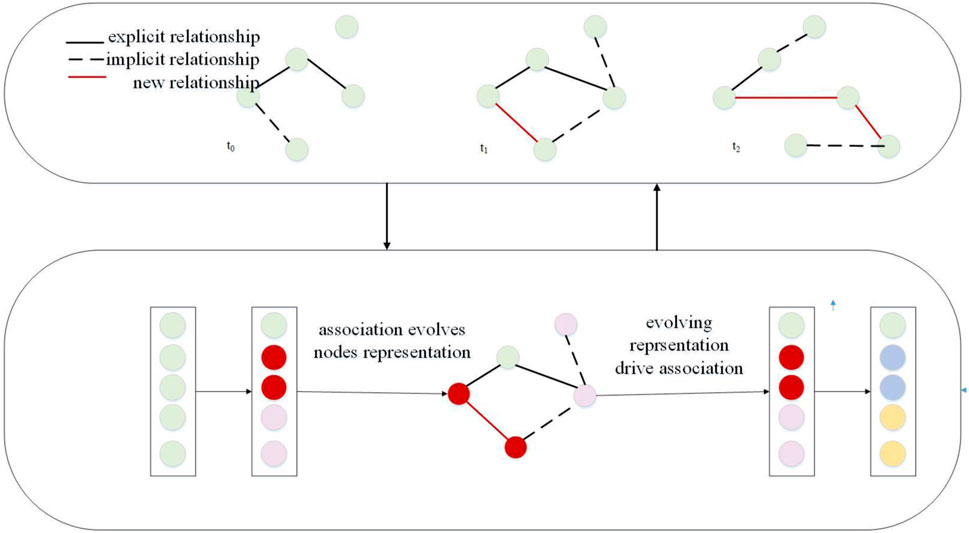
Figure 1. Schematic diagram of information dissemination dynamic network. The explicit relationships, implicit relationships, and new established relationships between nodes continue to undergo new changes over time.
In order to better understand the current research status and future development trends, we need to address the following two questions:
(1) How to effectively consider implicit relationships in social networks;
(2) How to effectively capture dynamic relationships in networks.
Existing references include various reviews, but these studies are concentrated on a limited part, with few considering the joint effects of communication and association processes on updating node representations. To address these two issues, this study introduces the DyRep model [16, 17]. It considers the joint effects of communication and association processes to update node representations while simulating the driving effects of representing both processes. Additionally, to better capture dynamic network relationships, this study combines theories related to relationship strength from social communication studies, incorporates an information feedback mechanism, and establishes a more suitable dynamic network representation model, DNIRep, for analyzing information propagation and diffusion in social networks. The study divides the dynamic network of information propagation into explicit relationship networks and implicit relationship networks, using changes in explicit relationships to influence interactions in implicit relationships, driving the network dynamically, and obtaining network representations through the mutual driving of the two sub-networks in an inductive manner. Furthermore, by introducing a feedback mechanism, after aggregating and updating information at nodes, the information is fed back to the neighborhood, enhancing the efficiency of dynamic network representation.
The main contributions of this study are summarized as follows:
(1) Propose a new DNIRep model, a dynamic reparameterization method for training, aimed at improving the performance of Rep with minimal overhead. By dynamically identifying key operations during training, our proposal achieved significant efficiency and performance improvements.
(2) Our DyRep is more friendly to downstream tasks, such as object detection. Unlike previous Rep and NAS methods that require training a network on an image classification task and then transferring it to downstream tasks, DyRep can directly adjust its structure in downstream tasks. This feature greatly reduces the computational cost.
Extensive experiments on image classification and its downstream tasks have shown that DNIRep outperforms other Rep methods in both accuracy and runtime overhead.
The study considers the process of real rumor information propagation as a continuous model of viewpoint interaction. The model views the information interaction process as the interaction of viewpoint values among user nodes. When the rumor information propagation occurs between users, the viewpoint values of user nodes also undergo corresponding changes. Based on this, the study proposes an inductive learning framework that learns a set of functions to extract time-evolving information about nonlinear dynamics and the interactions between nodes in a nonlinear dynamic control graph. The nodes’ viewpoint values are updated based on the intake of information.
Connections among individuals can be classified as explicit and implicit. American sociologist Keuchenius believed that the main criteria for categorization interpersonal relationships are the strength of interaction and emotional connection between individuals. Chen etal [18] proposed relationships with frequent interaction and close emotional ties are regarded strong relationships, while relationships with less interaction and weaker emotional connections are considered weak relationships. The theory of relationship strength is utilized to the division of social networks. The existing network of relationships between users can be seen as a explicit relationship network, where information can easily propagate. On the other hand, the propagation network formed by information exchange between users can be seen as a implicit relationship network, where interactions occur only at specific moments for specific events or information, representing temporary and short-term relationships.
Based on the real networks rumor propagation process, whether the relationship between nodes is explicit or implicit, as long as there is information propagation between nodes, it will lead to changes in the viewpoint values of the nodes. Therefore, the study roughly categorizes the changes in the viewpoint values of user nodes in the information propagation network into two types:
(1) When there are explicit relationships between nodes and rumor information propagation occurs between them, the strength of the connections and the node values’ perspectives change accordingly.
(2) When there are implicit relationships between nodes, with the propagation of rumor information, new associations and information propagation behaviors are formed between the nodes. As a result, the strength of the relationships and the values of the nodes’ viewpoints change.
Based on the above theory, the study defines the dynamic propagation network at time t as follows
In the equation, u and v represent two nodes that undergo changes, t represents the moment in time, and k serves as a label,
Behavioral intentions are primarily influenced by information providers, recipients, content, and external environment, which in turn determine specific behaviors [19]. It is emphasized that Weibo users are not only influenced by individual subjective intentions when forwarding information but also by information content and objective environment. The Theory of Planned Behavior emphasizes the impact of individuals and information content on the intention to forward, while Social Cognitive Theory emphasizes the influence of individual self-efficacy and environmental factors on the intention to forward, particularly highlighting the importance of environmental factors on individual behavior [20]. Therefore, this study explains user information forwarding behavior based on the complementary relationship between the Theory of Planned Behavior and Social Cognitive Theory. The information mutual influence model is constructed as shown in Figure 2.
(1) The aggregation of information between nodes and the feedback of changing information cause the relationship strength and viewpoint values of nodes to change accordingly, thus allowing users to establish new relationships (explicit and implicit relationships).
(2) The past changes of the node itself lead to changes in the viewpoint value of the node (such as time decay), therefore the representation of the node update is shown as Formula 2.
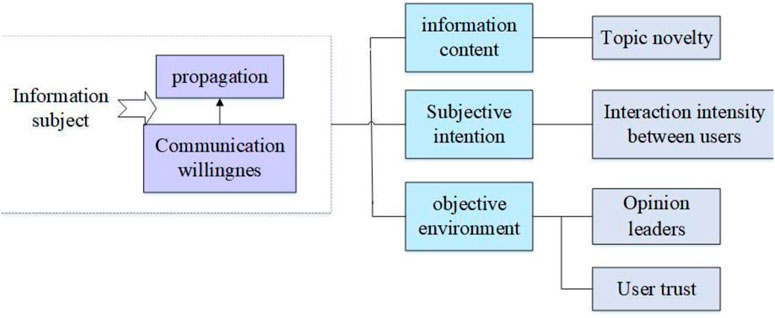
Figure 2. The study explains user information forwarding behavior based on the complementary relationship between the Theory of Planned Behavior and Social Cognitive Theory, and analyzes the influencing factors of user forwarding behavior.
In the equation,
Based on the types of node changes, we make the following assumptions:
(1) Nodes i and j have no relationship at time
(2) Nodes i and j have no relationship at time At time
In the equation,
(3) Nodes i and j already have a relationship at time
In the equation,
In the equation,
In the process of local network propagation, the model established in this study fully captures the rich neighborhood structural information of nodes. Next, we will aggregate the network node information. In order to fully consider the importance of nodes, this study introduces an attention mechanism to measure the weights of each node. Considering the dynamic nature of the network, this study introduces the Softmax function to output the aggregated information in vector form. Therefore, the definition of the aggregated output vector for the neighborhood information of node i is
In the equation,
In order to improve the speed of network updates, the study introduces a feedback mechanism to propagate the information of node i to its neighboring nodes. When the network undergoes dynamic changes, the association strength and viewpoint values of network nodes also change. After node i updates its representation, it feeds back its own change information to the neighborhood, and the update of the viewpoint values of neighboring nodes is shown in Formula 8.
In the equation,
In order to establish a more realistic directed network, the BA network model is enhanced. Compared with other complex network models, scale-free networks are more aligned with the actual social situations. However, the undirected nature of the BA network model cannot reflect the directed characteristics of real social networks, it cannot be used directly. In our study, two characteristics, namely, directedness and dynamic updating, are added to the BA network model, creating a dynamic adaptive network to simulate actual social networks.
The process of establishing a BA dynamic adaptive network is as follows: first, a random network is created with a certain number of nodes, then, new nodes are added one by one. Each newly added node connects to existing nodes through m directed edges, and the probability of connecting to a node is proportional to its degree. In this way, a BA directed adaptive network with n nodes is constructed. In the simulation, the BA network is not static but changes in coordination with viewpoint values, mutually influencing each other.
Combining the topological rules of scale-free networks, in this section, the initial network is established to have 30 nodes. Then, new nodes are added, and each new node randomly generates an initial random network with 480 edges. Based on this network, new nodes are constantly being added, and it is defined that for each new node introduced, it will generate five edges to connect with existing nodes with a certain probability. This connection probability is proportional to the number of edges of the existing nodes. Eventually, an initial scale-free network is created with 100 nodes and an average degree value of 8.8. This network is utilized as the initial viewpoint distribution environment in the subsequent simulation process. The same network is used throughout the simulation to represent the strength of attention relationships and the changes in viewpoint values in the population network. It is assumed that the initial viewpoints of individuals are uniformly distributed in the range of [0–1] to ensure comparability in the experimentIt is assumed that the initial viewpoints of individuals are uniformly distributed in the range of [0–1] to ensure comparability in the experiment.
The research model is compared with other baseline models over time, and we introduce the models for comparison.
The DyRep model is a representative model of inductive learning algorithms. This algorithm solves the drawback of previous transductive learning, which requires retraining when the network structure changes. Through inductive learning algorithms, it no longer learns the fixed representation of nodes, but rather learns the representation method of nodes. This means that even if the structure changes, it can easily obtain new node representations, greatly improving time efficiency.
The Localized Data Generation (LDG) model increases the amount of data and indirectly improves the quality of the proxy model by generating data within the neighborhood of the evaluation data. This method effectively helps the model better adapt to local data distributions, thereby improving the model’s generalization ability and performance. The LDG model plays an important role in data-driven evolutionary algorithms and graph neural networks, providing more localized information for model training and optimization.
To test the time efficiency of the proposed model in this paper, the representative model of inductive learning algorithm DyRep, and the LDG model with the addition of a bilinear encoding layer, 10 tests were conducted, and the average results are shown in Figure 3.
From Figure 3, it can be observed that the proposed model in this study showed an average time efficiency improvement of 25.90% compared to the DyRep model and 14.52% compared to the LDG model. In conclusion, the DNRep model proposed in this paper exhibits the best overall performance in terms of network dynamic representation and time efficiency in the experiments. In general, the improvements made in this study are effective.
This study conducted a feasibility analysis on four dimensions: topic novelty, interaction intensity between users, opinion leaders, and user trust. The results are shown in Table 1.
The results from Table 1 indicate that the reliability coefficients are all above 0.7, indicating that the scale has high stability, reliability, and internal consistency. This means that the four dimensions of influencing factors have a high level of reliability and their relationships are closely related, allowing them to be considered as a whole. The KMO test values for the data obtained in this study are shown in Table 2, which analyze the validity of the data and verify the influence of different dimensional factors on rumor propagation.
In Table 2, the KMO values for each influencing factor are all greater than 0.9, indicating a high level of correlation between variables and thus making them suitable for factor analysis. The significance level is 0.000, which means that the observed differences are highly significant and lower than the commonly accepted significance level (usually set at 0.05 or 0.01). Therefore, we can conclude that the differences between the four dimensional variables hypothesized in this study are highly significant.
(1) When the node i and j have no association at time
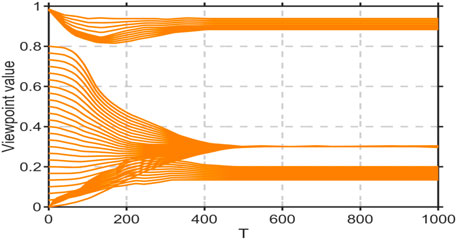
Figure 4. When the node i and j have no association at time t-1 and at time t, user i and user j spread rumor information without creating new associations. In this case, our study assumes a threshold ℇ = 0.2 to simulate dynamic network opinion evolution.
When there is no association between nodes and the trust level between them is low, the opinions of the nodes are typically dispersed and not unified. Since only rumor information interactions occur between nodes without creating new associations, after a period of information exchange, there are still a large number of nodes with dispersed opinion values in the network, indicating that the trust level between network nodes remains low, resulting in a large number of stubborn individuals. However, the opinion values of some nodes may still converge and form opinion clusters through the interaction of rumor information. In the initial stage of rumor generation, network users actively participate in the discussion of rumor information, but the trust level between them is low, resulting in the presence of loosely connected small groups in the network. As the network sentiment evolves, there is continuous information exchange between network nodes, and the network opinions gradually exhibit clustering, with the network core mainly occupied by high-authority nodes.
(2) When the node i and j have no association at time
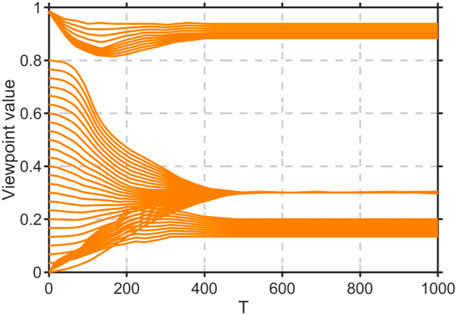
Figure 5. Dynamic Network Opinion Evolution (ℇ = 0.5)When the node i and j have no association at time t-1, but a new association is formed between user i and user j at time t, In this case, our study assumes a threshold ℇ = 0.5 to simulate dynamic network opinion evolution.
In the initial stage of rumor outbreak, when there is no association between nodes and the trust level is low, there are still a large number of “nonconformists” in the network. As the network sentiment evolves, there is continuous information exchange between network nodes, leading to the formation of new associations between nodes and an increase in trust. Compared to the case of ℇ = 0.2, the number of small groups in the network is significantly reduced. At this stage, the network opinions exhibit more obvious clustering, and the opinion values of nodes show more obvious convergence. As the network sentiment evolves, there is continuous information exchange between network nodes, and the network opinions gradually exhibit higher levels of clustering.
(3) When the node i and j already have an association at time
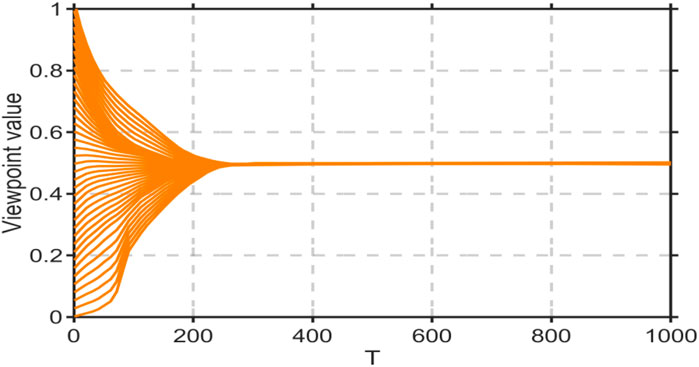
Figure 6. When the node i and j already have an association at time t-1, and there is a rumor information propagation from user i to user j at time t, In this case, our study assumes a threshold ℇ = 0.8 to simulate dynamic network opinion evolution.
When the trust level between network nodes is high, the opinion values of network nodes show strong convergence. Therefore, compared to the cases of ℇ = 0.2 and ℇ = 0.5, when ℇ = 0.8, The viewpoints between nodes become more unified. Due to the high degree of connection between nodes, they exhibit high levels of trust. With the interaction of information between different nodes in the social network, the viewpoints between nodes converge to 0.5, and multiple loosely structured small entities disappear.
Figures 7, 8 and 9 respectively represent the distribution of opinion values of network nodes under different levels of trust and the changes in opinion values of network nodes under different levels of trust. Figure 9 represent the change in standard deviation of nodes under different levels of trust. When the degree of association between nodes is low, the level of trust between them is also low. In this case, there are more opinion groups in the network, and the opinions of network nodes tend to be diverse. By examining the standard deviation of node values, it can be observed that when the degree of association between nodes is low, the standard deviation of node values is also smaller, indicating that nodes are less likely to be influenced by other nodes and change their opinions. As the level of trust between network nodes increases, the number of opinion groups in the network decreases, and the opinions between nodes tend to converge. At the same time, the change in opinion values of network nodes increases, and the standard deviation also increases. This indicates that as the level of trust between network nodes increases, nodes are more likely to be influenced by other nodes and change their opinions.
In social networks, the relationships between network nodes are usually weak. In such cases, novel topics can effectively attract the attention of other nodes, leading to their interest and even resharing. This disrupts the relatively stable and low-intensity positional changes between network nodes. Therefore, in this study, we added a node that publishes novel topics to the existing defined network structure and connected it with other nodes. We set the novelty of the topic as 1, indicating its influence on guiding public opinion. Based on previous studies, nodes exhibit different changes in opinion values depending on their level of trust. Therefore, we selected trust levels of ℇ = 0.2 and ℇ = 0.8 as the subjects of our study to investigate the impact of topic novelty on node opinion values under different levels of trust。
When the trust level between network nodes is low (ℇ = 0.2), the evolution of opinion values of different nodes in the social network is shown in Figure 10.
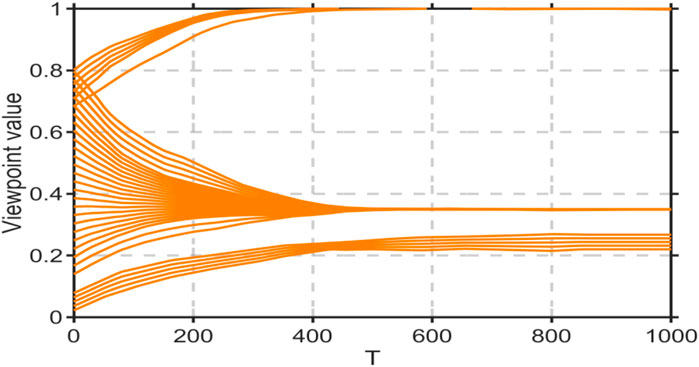
Figure 10. The impact of novel topics on the evolution of network node opinion values when nodes levels of trust ℇ = 0.2.
In the early stages of rumor propagation, novel topics attract the attention of some stubborn nodes for a shorter period of time, causing the opinion values of some individuals in the network to continuously align with the expected value of the novel topic, which is 1.0. Interventions based on topic novelty reduce the number of “nonconformist” individuals in the network and shorten the time for opinion convergence, resulting in fewer opinion clusters. However, there still exists a portion of individuals with significantly different opinions whose tendency values towards 0.3. These individuals have low willingness to compromise and persist in their own opinions.
When the trust level between network nodes is high (ℇ = 0.8), the evolution of opinion values of different nodes is shown in Figure 11.
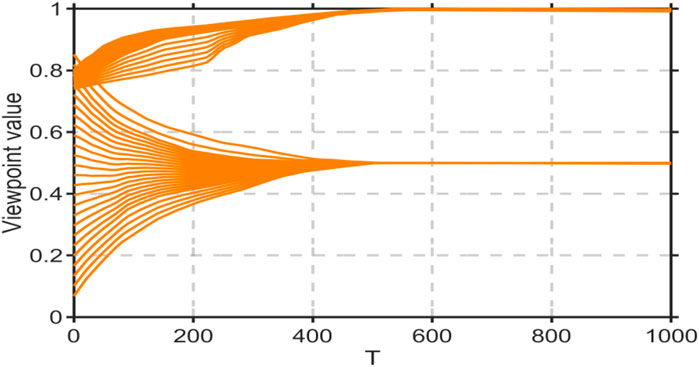
Figure 11. The evolution of network node opinion values under the influence of novel topics when nodes levels of trust ℇ = 0.8.
According to Figure 11, when there is a high level of trust between network nodes, the opinion values of nodes are more easily influenced by the opinions of novel topics. The trend of opinion value changes is more inclined towards the opinion value of topic novelty (1.0) compared to the low trust scenario. Even in high-trust environments, social media networks still have individuals with different opinions, but it is evident that the majority of network nodes’ viewpoints are influenced by the novelty of the topic, leading opinions to converge towards 1 and 0.5.
In social networks, there are always “active individuals” who have more followers and engagement, and they play the role of opinion leaders in the process of rumor generation and dissemination in the real social network. Based on the characteristics of real social networks, the number of opinion leaders is relatively small. Compared to ordinary network nodes, they are more likely to influence other network nodes associated with them but are relatively less influenced by other network nodes. Therefore, we will set one influential network node as Node 1 and assign its opinion value as 1.0. This study discusses the influence of opinion leaders on the evolution of opinion values of different network nodes under different trust levels (ℇ = 0.2 and ℇ = 0.8). The influence of opinion leaders permeates through different stages of the network public opinion. Therefore, this study divides rumor propagation into the early stage and the mid-stage to examine the evolution of opinion values of different nodes under different trust levels in each stage.
When the trust level between network nodes is low (ℇ = 0.2), the evolution of opinion values of different nodes during the early stage of rumor propagation is shown in Figure 12.
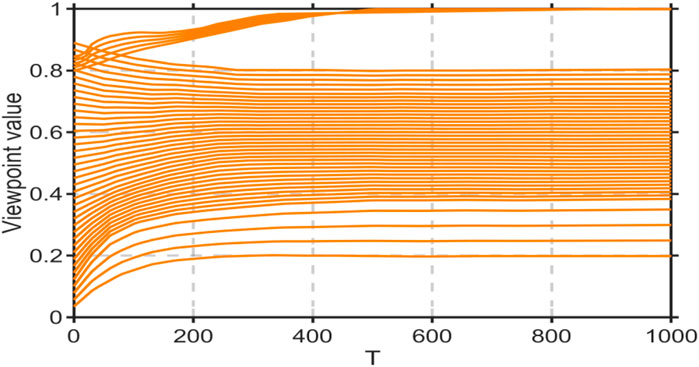
Figure 12. Influence of opinion leaders on the evolution of network node opinion values when nodes levels of trust ℇ = 0.2.
According to Figure 12, compared to the low trust scenario without opinion leaders, the average opinion value in the social network with opinion leader nodes tends to be 1.0, but the extent of change is limited. This is because opinion leader nodes are characterized by having more followers and engagement, so the rumors they spread attract more nodes. However, they may not necessarily have authority, so when trust is low, other nodes may also have dissenting opinions towards the expert nodes. As a result, there is no unified collective opinion, but rather scattered smaller opinion groups.
When the trust level between network nodes is high (ℇ = 0.8), the evolution of opinion values of different nodes during the early stage of rumor propagation is shown in Figure 13.
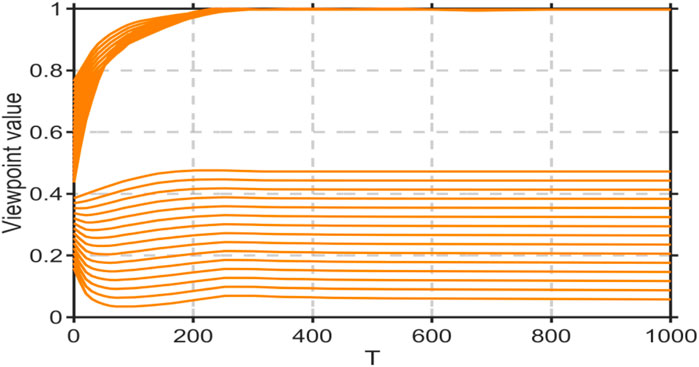
Figure 13. Influence of opinion leaders on the evolution of network node opinion values when nodes levels of trust ℇ = 0.8.
According to Figure 13, compared to Figure 11, as the trust level between network nodes increases, the average opinion value in the social network tends to be closer to 1.0. Additionally, due to the increased trust between nodes, other nodes also show a higher level of agreement with the opinions of opinion leaders. Therefore, compared to the scattered and smaller opinion groups in the low trust scenario, in the presence of opinion leaders, the size of the opinion collective increases, and the opinions tend to be more unified.
During the mid-stage of rumor propagation, when the trust level between network nodes is low (ℇ = 0.2), the evolution of opinion values of different nodes is shown in Figure 14.
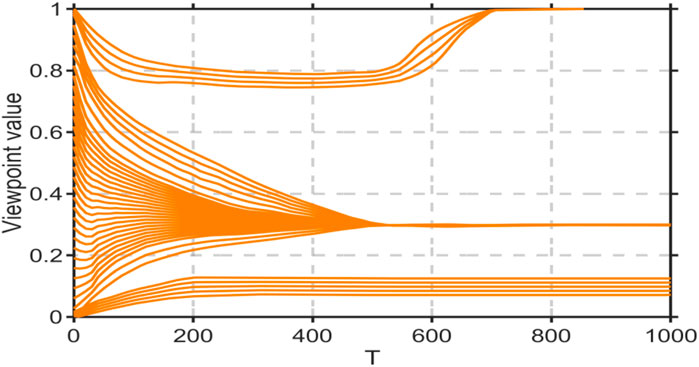
Figure 14. Influence of user influence intervention on the evolution of network node opinion values during the mid-stage when nodes levels of trust ℇ = 0.2.
In the case of low trust, the intervention of opinion leaders during the mid-stage of rumor propagation has a less effective influence. Most nodes remain unaffected and stubborn, while some nodes form a unified opinion group. Compared to the influence of opinion leaders on network nodes during the early stage of rumor outbreak, the intervention during the mid-stage is less effective in influencing other nodes. The reason is that after a period of rumor propagation, some network nodes have already formed stable opinions, and the trust level between nodes is low, resulting in less influence from other nodes. Therefore, intervention by opinion leaders in guiding public opinion should occur as early as possible.
From Figure 15, it can be observed that when the trust level between nodes is high (ℇ = 0.8), the intervention of opinion leaders during the late stage achieves the expected effect. Individual opinions in the social network converge towards an opinion value of 1.0 influenced by the opinion leaders. It is worth noting that, compared to the influence of opinion leaders during the early stage of rumor propagation, during the mid-stage intervention, the opinions of all nodes tend to align with the opinion value of the opinion leaders. We can conclude that if network nodes are initially guided by opinion leaders, they may initially deviate from the opinion leaders due to significant differences in opinion values. However, as the rumor information in the network evolves to a certain stage and the opinion values among nodes become consistent, the guidance of opinion leaders can make the opinion values of nodes align more closely with those of the opinion leaders.
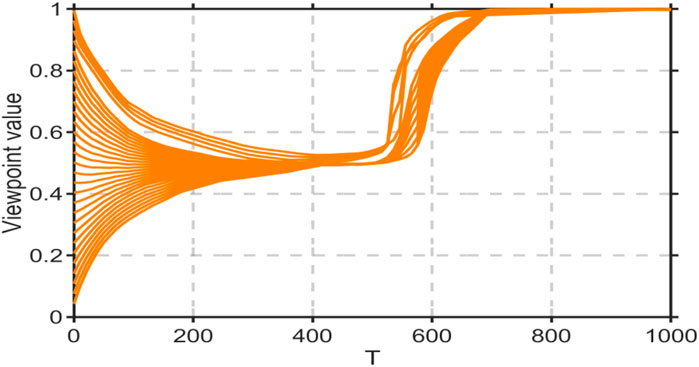
Figure 15. Influence of user influence intervention on the evolution of network node opinion values during the late stage when nodes levels of trust ℇ = 0.8.
The interaction between network nodes can accelerate the propagation of rumor information. Therefore, we need to verify the impact of information interaction on the evolution of rumor information in social networks. When the trust level between nodes is low (ℇ = 0.2), we conduct research on the evolution of opinion values.
From Figure 16, it can be observed that as the intensity of user interaction increases, although there are still a few individuals with stubborn opinions, the opinion values of the nodes converge and form larger opinion groups. This is because as the information interaction between nodes becomes more frequent, the trust level between nodes strengthens. As a result, the number of nodes with stubborn opinions decreases, and the opinions of nodes tend to become more unified.
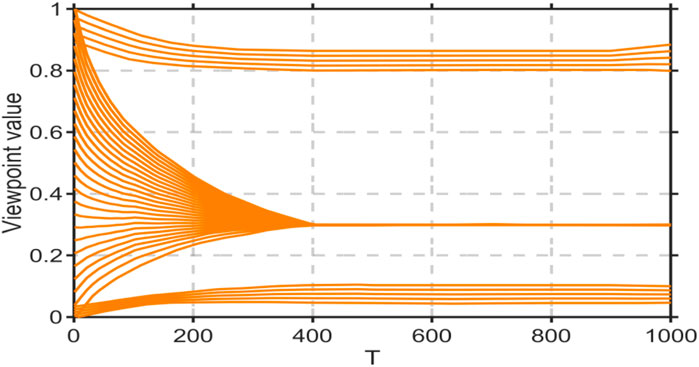
Figure 16. Influence of node information interaction on the change in network node opinion values when nodes levels of trust ℇ = 0.2.
When the trust level between nodes is low (ℇ = 0.8), we conduct research on the evolution of opinion values.
From Figure 17, it can be observed that when the trust level between nodes is high, with the continuous interaction of information between network nodes, nodes are quickly influenced by the opinions of other nodes, and the social network rapidly forms a cohesive group with unified opinions. With a high trust level, it is easier for nodes to form a unified opinion. With frequent information interaction between nodes, the process of forming a unified opinion among nodes is accelerated. In this chapter, a dynamic adaptive network model for bounded trust opinion evolution is proposed. The opinion evolution is analyzed from a macro statistical perspective and compared with statistical indicators in static networks. In the opinion evolution algorithm, different individuals use random distribution of opinions and reconnect probabilities, which is in line with real social situations. The improved directed BA network also better reflects real social relationship networks. However, the assumption that different individuals have the same level of trust does not fully align with some real social phenomena, as people are different and their knowledge backgrounds and life experiences cannot be completely identical.
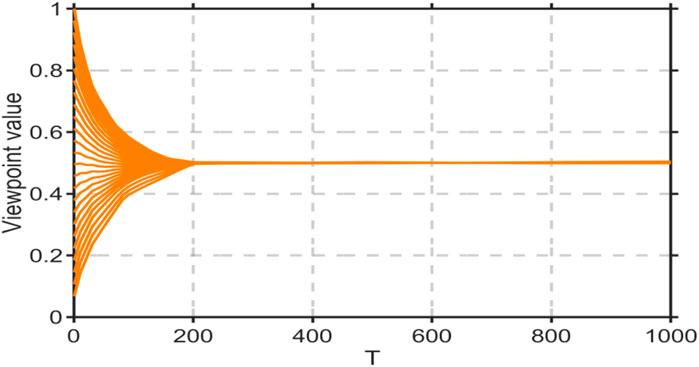
Figure 17. Influence of node information interaction on the change in network node opinion values when nodes levels of trust ℇ = 0.8.
This study provides a better description of the consensus or polarization and relationship evolution in the process of rumor information evolution in social networks with different levels of trust. It portrays the characteristics of authentic rumor information dissemination and the guiding role of topics, opinion leaders, and opinion interaction in public opinion. It can also provide timely guidance and supervision for public crises, avoiding unnecessary blind following and panic, and playing an crucial role in maintaining social stability.
Firstly, this study discusses the changes in opinion values in social networks under different trust thresholds. The different trust levels between network nodes directly affect their attention and forwarding behavior. In particular, there are often stubborn nodes in real social networks whose opinions are not easily swayed by other nodes. Through experiments, It can be inferred that when the trust threshold between nodes is higher, the network nodes are more likely to change their opinion values due to the influence of other nodes. At this time, the opinion values of different nodes in the network are more likely to converge, and the convergence speed is faster. Therefore, we found that the network nodes converge quickly, and the number of stubborn individuals decreases. Therefore, through experiments, we found that when the trust threshold between nodes increases, the convergence speed of network nodes accelerates, and the number of individuals with fixed ideas significantly decreases.
At the same time, this study analyzes the factors influencing node information dissemination and studies the impact of different trust levels and influencing factors on rumor information dissemination at different stages. When the trust level between nodes is low, novel topics can better attract the attention of different nodes and accelerate the interaction between information. However, due to the low trust level between nodes, there are still a large number of stubborn nodes. For nodes willing to change their opinion values, novel topics accelerate the formation of opinion groups. As for the influence of opinion leaders, they can also accelerate the formation of opinion groups, but due to the lack of authority and the low trust level between nodes, the change in opinion values of stubborn individuals is still not significant. The direct interaction between nodes in information exchange leads to faster changes in opinion values, but it still cannot change the opinion values of stubborn nodes.
When the trust level between nodes is high, novel topics can quickly attract the attention of other nodes. Moreover, due to the high trust level between nodes, not only novel topics accelerate the formation of opinion groups but also make it easier for network nodes to form a unified opinion. As for opinion leaders, their influence on other nodes is prominent in different stages of rumor dissemination. In the early stage of rumor information dissemination, the influence of opinion leaders on network nodes is more significant.
Based on the summary of the experimental results in this study, we believe that in social networks, higher trust thresholds are more effective in accelerating information dissemination and guiding the process of rumor propagation, thereby avoiding malicious spread of rumors and instability in online public opinion. In addition, different guidance methods should be employed at different stages of rumor information dissemination. After a certain period, the guidance effect of opinion leaders is more significant than the interaction between nodes. At the early stage of spreading rumors, different methods have shown good effects in guiding information. This also reflects the importance of taking effective measures early on when guiding rumor information to achieve better results. This provides a theoretical basis for the formulation of public opinion guidance policies. Next, the focus will shift to network representation learning on a large-scale dynamic network, utilizing representation learning to enhance downstream machine learning tasks and thereby improve the efficiency of information propagation dynamic models.
The raw data supporting the conclusions of this article will be made available by the authors, without undue reservation.
MZ: Funding acquisition, Methodology, Software, Supervision, Writing–original draft, Writing–review and editing. LL: Conceptualization, Data curation, Formal Analysis, Investigation, Supervision, Validation, Methodology, Writing–review and editing. YW: Formal Analysis, Project administration, Resources, Visualization, Data curation, Writing–original draft.
The author(s) declare that financial support was received for the research, authorship, and/or publication of this article. This work was supported by the National entrepreneurship training program (202210671144X).
The authors declare that the research was conducted in the absence of any commercial or financial relationships that could be construed as a potential conflict of interest.
All claims expressed in this article are solely those of the authors and do not necessarily represent those of their affiliated organizations, or those of the publisher, the editors and the reviewers. Any product that may be evaluated in this article, or claim that may be made by its manufacturer, is not guaranteed or endorsed by the publisher.
1https://www.researchgate.net/publication/326427691_Real-Time_Graph_Partition_and_Embedding_of_Large_Network
2https://dl.acm.org/doi/10.1109/CCGRID.2018.00070
1. Piqueira J, Zilbovicius M, Batistela C. Daley–Kendal models in fake-news scenario. PHYSICA (2020) 548:123406. doi:10.1016/j.physa.2019.123406
2. Centola D, Victor M, Macy M. Cascade dynamics of complex propagation. Physica A Stat Mech Appl (2012) 374:449–56.
3. Butts D, Bollman S, Murillo M. Mathematical modeling of disinformation and effectiveness of mitigation policies. Scientific Rep (2023) 13:18735. doi:10.1038/s41598-023-45710-2
4. Perozzi B, Alrfou R, Skiena S. DeepWalk:online learning of social reresentations. In: Proceedings of 20th ACM SIGKDD international conference on knowledge discovery and data mining (2014). p. 701–10.
5. Grover A, Leskovec J. Node2vec:scalable feature learning for networks. In: Proceedings of the 22nd ACM SIGKDD international conference on knowledge discovery and data mining (2016). p. 855–64.
6. Goyal P, Kamran N, Hex R. Dyn GEM: deep embedding method for dynamic graphs (2021):168–175. Available from: https://arxiv.org/abs/1805.11273.
7. Liu WQ, Li HX, Xie B. Real-time graph partition and embedding of large network. In: Proceedings of the 18th IEEE/ACM international symposium on cluster, cloud and grid computing (2018). p. 432–41. doi:10.1109/CCGRID.2018.00070
8. Chanathip P, Liu X, Pattararat K, Natthawut K. Enhancing citation recommendation using citation network embedding. Scientometrics (2022) 127:233–64. doi:10.1007/s11192-021-04196-3
9. Wang Q, Yu YH, Gao HY, Zhang L, Cao Y, Mao L, et al. Network representation learning enhanced recommendation algorithm. IEEE Access (2019) 7:61388–99. doi:10.1109/ACCESS.2019.2916186
10. Chen Q, Wang Y, Tang X. A symptotical outer synchroniza tion for the controlled complex dynamic networks with unknown bounded interaction. Int J Control Automation Syst (2023) 21(4):1080–8. doi:10.1007/s12555-021-0750-4
11. Chen Q, Wang Y, Tang X, et al. A symptotical outer syn-chronization control of the complex dynamical networks via unknown interaction and links dynamics. Mathe matical Methods Appl Sci (2023) 46(4):4379–90.
12. Gao ZL, Wangy H. The structural balance analysis of complex dynamical networks based on nodes' dynamical couplings. PLoS One (2018) 13(1):e0191941. doi:10.1007/s40747-022-00840-4
13. Clauio DT, Barros MRF, Mendonca N. A survey on embedding dynamic graphs. ACM comput Surv (2021) 55:1–37. doi:10.1145/3483595
14. Xing ZZ, Song R, Teng Y, Xu H. DynHEN: a heterogeneous network model for dynamic bipartite graph representation learning. Neurocomputing (2022) 508:47–57. doi:10.1016/j.neucom.2022.08.050
15. Tian H, Zheng XL, Zhao K, Liu WJ, Zeng DD. Inductive representation learning on dynamic stock CoMovement graphs for stock predictions. Informs J Comput (2022) 34:1940–57. doi:10.1287/ijoc.2022.1172
16. Friedkin NE. Information flow through strong and weak ties in intraorganizational social networks. Social Networks (1982) 3:273–85. doi:10.1016/0378-8733(82)90003-x
17. Trivedi R, Farajtabar M, Biswal P. DyRep:learning representations over dynamic graphs (2021). Available from: https://arxiv.org/abs/1803.04051.
18. Chen Q, Min C, Zhang W, Wang G, Ma X, Evans R. Unpacking the black box:How to promote citizen engagement through government social media during the COVID–19 crisis. Comput Hum Behav (2020) 18 (1):118. doi:10.1016/j.chb.2020.106380
19. Du HT, Meng QG, Wan JZ. The network struture and Propagation characteristics of Microblog community based on social network analysis. J China Soc Scientific Tech Inf (2016):838–47.
20. Zainuddin ZAA, Nurhaedar J, Jafar N, Suriah , Nursalam , Darmawansyah , et al. The application of social cognitive theory (SCT) to the mHealth diabetes physical activity (PA) app to control blood sugar levels of type 2 diabetes mellitus (T2DM) patients in Takalar regency. J Public Health Res (2023):1–23. doi:10.1177/22799036231172759
Keywords: temporal characteristics, dynamics, dynamic network, feedback mechanism, opinion dispersion
Citation: Zhang M, Liu L and Wang Y (2024) Research on the dynamic spread of information in social networks based on relationship strength theory and feedback mechanism. Front. Phys. 12:1327161. doi: 10.3389/fphy.2024.1327161
Received: 24 October 2023; Accepted: 02 July 2024;
Published: 23 July 2024.
Edited by:
José Roberto Castilho Piqueira, University of São Paulo, BrazilReviewed by:
Cristiane Batistela, University of São Paulo, BrazilCopyright © 2024 Zhang, Liu and Wang. This is an open-access article distributed under the terms of the Creative Commons Attribution License (CC BY). The use, distribution or reproduction in other forums is permitted, provided the original author(s) and the copyright owner(s) are credited and that the original publication in this journal is cited, in accordance with accepted academic practice. No use, distribution or reproduction is permitted which does not comply with these terms.
*Correspondence: Yingxu Wang, d2FuZzIwMjEwNzAzQDE2My5jb20=
Disclaimer: All claims expressed in this article are solely those of the authors and do not necessarily represent those of their affiliated organizations, or those of the publisher, the editors and the reviewers. Any product that may be evaluated in this article or claim that may be made by its manufacturer is not guaranteed or endorsed by the publisher.
Research integrity at Frontiers

Learn more about the work of our research integrity team to safeguard the quality of each article we publish.